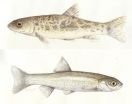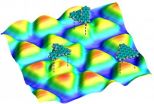(Press-News.org) An international team led by the Forest Technology Centre of Catalonia has carried out the first large-scale study of the threats facing freshwater fish in the Mediterranean basin. Invasive species, along with over-exploitation of water resources, are the most important pressures, and those that expose fish to the greatest risk of extinction.
"The continental fish of the Mediterranean basin are one of the most threatened biological groups in the world", Miguel Clavero, lead author of the study and a researcher from the Landscape Ecology Group of the Forest Technology Centre of Catalonia, tells SINC.
The study, which has been published in the journal Diversity and Distributions, looks at the geographical distribution of the manmade factors (pressures) with a negative impact on biodiversity and their relationship to the degree of threat faced by endemic freshwater fish communities in the Mediterranean basin. The study combined information on the pressures affecting 232 fish species and their distribution range.
"The Iberian Peninsula is one of the areas in which invasive species have the greatest impact on native fish", explains Clavero. His team has studied the commonest pressures, such as pollution, water extraction, invasive species, reservoirs, agriculture and over-fishing.
By relating the distribution of these pressures with the degree of threat faced by the fish in each area, the researchers have shown that "fish communities are exposed to the greatest threat of extinction when the most significant pressures are the impact of invasive species and over-exploitation of water resources", the expert says.
Clavero says "these two pressures are the leading causes of biodiversity loss among continental fish in the Mediterranean region". The results bear out those of other studies on a smaller geographic scale carried out in various parts of the Mediterranean.
"We also have notorious examples in Spain of the negative effects of the over-exploitation of water resources, as is the case in the upper basin of the Guadiana (including the Tablas de Daimiel wetlands)", the scientist adds.
The biggest analysis of the Mediterranean basin
The research team compiled the information evaluating the conservation status of endemic continental fish species in the Mediterranean basin drawn up by the International Union for the Conservation of Nature (IUCN) Centre for Mediterranean Cooperation.
The scientists calculated the number of fish species affected by each type of pressure in 10x10 km areas in the Mediterranean basin. "This allowed us to describe the geographical variation in the impacts caused by the various pressures, which could then be related to the extinction risk for the fish communities", explains Clavero.
The team used data on two geographical scales (aside from the 10x10 km areas, they also analysed complete river basins), as well as two complementary indicators on extinction risk, based on the IUCN categories of threat.
INFORMATION:
References:
Clavero, Miguel; Hermoso, Virgilio; Levin, Noam; Kark, Salit. "Geographical linkages between threats and imperilment in freshwater fish in the Mediterranean Basin" Diversity and Distributions 16(5): 744-754, septiembre de 2010. DOI:10.1111/j.1472-4642.2010.00680.x
Invasive species -- the biggest threat to fish in the Mediterranean basin
2010-11-12
ELSE PRESS RELEASES FROM THIS DATE:
Scientists at IRB Barcelona and BSC publish the world's largest video data bank of proteins
2010-11-12
After four years of conducting intensive calculations in the supercomputer MareNostrum at the Barcelona Supercomputing Center, scientists headed by Modesto Orozco at the Institute for Research in Biomedicine (IRB Barcelona) have presented the world's largest data base on protein motions. Called MoDEL, this new database holds more than 1,700 proteins and is partially accessible through Internet to researchers worldwide. MoDEL has been developed to study the basic biology of proteins and to accelerate and facilitate the design of new pharmaceutical agents.
"Nowadays we ...
UT professors find mixing business with politics pays off
2010-11-12
Now that the 2010 election is over, here is something to consider for the 2012 race: If you want to fatten your company's profits, contribute to a political campaign.
A study by two College of Business Administration professors at the University of Tennessee, Knoxville, found that when firms engage in corporate political activities, such as lobbying and making campaign contributions, they enjoy about 20 percent higher performance. The study, by Russell Crook and David Woehr, along with Sean Lux of the University of South Florida, entitled "Mixing Business with Politics: ...
Teens' take on bullying
2010-11-12
Both the bully and the victim's individual characteristics, rather than the wider social environment, explain why bullying occurs, according to Swedish teenagers. The new study, by Dr. Robert Thornberg and Sven Knutsen from Linköping University in Sweden, also shows that 42 percent of teenagers blamed the victim for the bullying. The study is published online in Springer's journal, Child & Youth Care Forum.
In one of the rare studies investigating young people's views on why bullying takes place in school, Thornberg and Knutsen explored how teenagers explain bullying ...
Step by step toward tomorrow's nanomaterial
2010-11-12
Electronic components are getting smaller and smaller, with microelectronic components gradually being replaced by nanoelectronic ones. On nanoscale dimensions, silicon, which is at the present stage the most commonly used material in semiconductor technology, reaches however a limit, preventing further miniaturization and technological progress. New electronic materials are therefore in great demand. Due to its outstanding electronic properties, graphene, a two-dimensional carbon network, is considered as a possible replacement. However, several obstacles must be overcome ...
Circuitry of fear identified
2010-11-12
Fear arises in the almond-shaped brain structure known as the amygdala. It is the amygdala which processes the strange noise, shadowy figure or scary face and not only triggers palpitations or nausea but can also cause us to flee or freeze. That much has long been known about the function of this part of the brain. What remains largely unclear, however, is precisely how fear develops, and which of the countless neurons in the amygdaloid region are involved in this process. But finding answers to these questions is vital for those who wish to improve the quality of life ...
African dust caused red soil in southern Europe
2010-11-12
Spanish and American researchers have conducted a mineralogical and chemical analysis to ascertain the origin of "terra rossa" soil in the Mediterranean. The results of the study reveal that mineral dust from the African regions of the Sahara and Sahel, which emit between 600 and 700 tonnes of dust a year, brought about the reddish soil in Mediterranean regions such as Mallorca and Sardinia between 12,000 and 25,000 years ago.
"The first hint of the relationship between African dust and certain soils in the region of the Mediterranean is their reddish or reddish-brown ...
Alcohol damages much more than the liver
2010-11-12
MAYWOOD, Ill. -- Alcohol does much more harm to the body than just damaging the liver. Drinking also can weaken the immune system, slow healing, impair bone formation, increase the risk of HIV transmission and hinder recovery from burns, trauma, bleeding and surgery.
Researchers released the latest findings on such negative effects of alcohol during a meeting Nov. 19 of the Alcohol and Immunology Research Interest Group, held at Loyola University Medical Center.
At Loyola, about 50 faculty members, technicians, post-doctoral fellows and students are conducting alcohol ...
Leaking underground CO2 storage could contaminate drinking water
2010-11-12
DURHAM, N.C. -- Leaks from carbon dioxide injected deep underground to help fight climate change could bubble up into drinking water aquifers near the surface, driving up levels of contaminants in the water tenfold or more in some places, according to a study by Duke University scientists.
Based on a year-long analysis of core samples from four drinking water aquifers, "We found the potential for contamination is real, but there are ways to avoid or reduce the risk," says Robert B. Jackson, Nicholas Professor of Global Environmental Change and professor of biology at ...
Sugar and slice make graphene real nice
2010-11-12
HOUSTON -- (Nov. 11, 2010) -- Future computers may run a little sweeter, thanks to a refinement in the manufacture of graphene at Rice University.
Rice researchers have learned to make pristine sheets of graphene, the one-atom-thick form of carbon, from plain table sugar and other carbon-based substances. They do so in a one-step process at temperatures low enough to make graphene easy to manufacture.
The lab of Rice chemist James Tour reported in the online version of the journal Nature this week that large-area, high-quality graphene can be grown from a number of ...
Scripps Research scientists identify new mechanism regulating daily biological rhythms
2010-11-12
JUPITER, FL, November 9, 2010 – For Immediate Release – Scientists from the Florida campus of The Scripps Research Institute have identified for the first time a novel mechanism that regulates circadian rhythm, the master clock that controls the body's natural 24-hour physiological cycle. These new findings could provide a new target not only for jet lag, shift work, and sleep disturbances, but also for disorders that result from circadian rhythm disruption, including diabetes and obesity as well as some types of cancer.
The study is published in the November 12, 2010 ...



